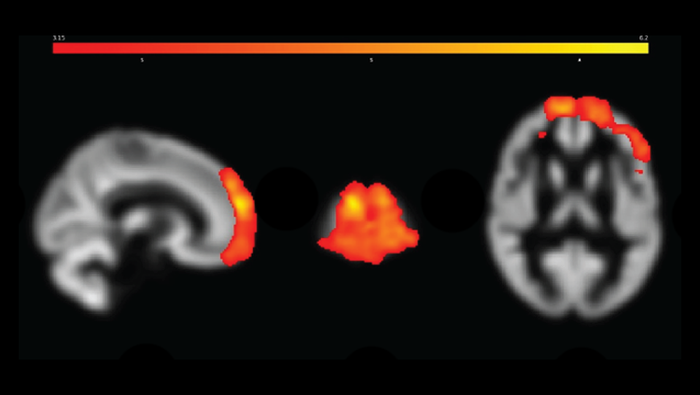The brains of Gulf War Veterans with chronic pain possess larger pain processing regions and smaller pain regulation regions compared to their healthy peers, according to new research published in JNeurosci.

Credit: Ninneman et al., JNeurosci 2022
The brains of Gulf War Veterans with chronic pain possess larger pain processing regions and smaller pain regulation regions compared to their healthy peers, according to new research published in JNeurosci.
Over one third of Gulf War Veterans experience widespread, chronic pain linked to a condition called Gulf War Illness. The underlying cause of the pain is poorly understood, preventing the development of effective treatments. Ninneman et al. analyzed the brains of Gulf War Veterans with and without pain using MRI. The participants also completed questionaries about their pain symptoms, fatigue, and mood.
Those with chronic pain displayed smaller left and right insular cortices, two brain areas involved in regulating pain. They also had larger areas of the frontal cortex, specifically in regions involved in pain sensitivity and emotional regulation. The structural changes were more pronounced in people with worse pain, but there was no relationship with fatigue or mood. These results indicate the chronic pain from Gulf War Illness may stem from changes in how the central nervous system processes pain, rather than with issues with nerves or pain receptors.
###
Paper title: Pain, but not Physical Activity, is Associated with Gray Matter Volume Differences in Gulf War Veterans with Chronic Pain
Please contact [email protected] for the full-text PDF and to join SfN’s journals media list.
About JNeurosci
JNeurosci, the Society for Neuroscience’s first journal, was launched in 1981 as a means to communicate the findings of the highest quality neuroscience research to the growing field. Today, the journal remains committed to publishing cutting-edge neuroscience that will have an immediate and lasting scientific impact, while responding to authors’ changing publishing needs, representing breadth of the field and diversity in authorship.
About The Society for Neuroscience
The Society for Neuroscience is the world’s largest organization of scientists and physicians devoted to understanding the brain and nervous system. The nonprofit organization, founded in 1969, now has nearly 37,000 members in more than 90 countries and over 130 chapters worldwide.
Journal
JNeurosci
DOI
10.1523/JNEUROSCI.2394-21.2022
Method of Research
Observational study
Subject of Research
People
Article Title
Pain, but not Physical Activity, is Associated with Gray Matter Volume Differences in Gulf War Veterans with Chronic Pain
Article Publication Date
13-Jun-2022
COI Statement
The authors have no conflict of interest to declare. This work is supported by the Department of Veterans Affairs (Grant #561-00436, IO1 CX000383, IO1 CX001329 and IK2 CX001679). The contents do not represent the views of the U.S. Department of Veteran Affairs or the United States Government.




